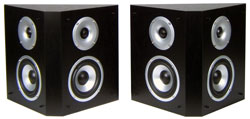Introduction to Surround Speakers
Surround sound speakers are an essential element in defining your digital home audio and home theater experience.
When choosing your Streem surrounds you have a choice of either a monopole or bipole design.
While each design offers different advantages over the other which one you choose will soley depend on your taste
and the effect you prefer. Below is a primer on surround speakers and what role they play in today's home theater.
Front and Center Channel Speakers
The main speakers, referred to as front left and front right, are responsible for reproducing the main sounds
in a soundtrack. The center channel speaker, usually found above the screen, is largely responsible for reproducing the character
voices in a soundtrack and anchoring those voices to the visuals. Adding speakers to the side and/or rear of the listening area
enables us to experience surround sound. By surrounding the listener with audio information the listener feels that they are
placed right in the center of the action.
Dolby Digital and DTS
The trend today in home theater is digital surround sound. Most notably
Dolby Digital and DTS (Digital Theater Systems), however Dolby Digital (5.1) is more widely supported and more prominently found
on todays DVD's. DTS, although arguably more accurate and desirable due to using less audio compression than Dolby Digital, is
currently a digital audio option only on select DVD movies.
Dolby Digital, and DTS, surround sound refers to the encoding of individual audio tracks or channels within a soundtrack. Each
channel in the digital theater is now capable of reproducing the full sound range (rather than a restricted matrix
of the main stereo channels of the early days of surround sound). Surround sound speakers as well as center channels
in a digital surround environment should now meet virtually the same demands as the front left and front
right main speakers. Rest assured that all of Streem's surround sound speakers are fully compatible with digital
surround sound technology.
Current Configurations
The purpose of a surround sound speaker is to immerse the listener within the sound stage to create a realistic 3D
environment. This effect is achieved by placing 2, 3 or sometimes 4 speakers in varying configurations and positions within
your listening room to the sides and/or behind the listening position.
Nowadays a standard home theater speakers setup would normally consist of five or six (and sometimes seven) speakers plus
a low frequency subwoofer. In a Dolby Digital 5.1 surround sound environment the speakers are called the left front, center,
right front, surround left, surround right and subwoofer. The "5" refers to the 5 speaker channels and the ".1" refers to the
subwoofer channel.
If your audio/video receiver or amplifier supports Dolby Digital EX you can also add another rear speaker directly
behind the listener (called the surround back channel). This enables you to experience 6.1 surround sound which more thoroughly
surrounds the listener increasing the realism of the experience.
Another variation on the 6.1 setup is referred to as a 7.1 configuration. Instead of one surround back channel two surround
back channels are used called the surround back left and surround back right. These two channels are actually the single surround
back channel in a Dolby Digital EX 6.1 setup and are not discrete channels themselves.
Monopole Speaker Design
 The monopole design is a familiar one with all drivers in the speaker cabinet oriented on the same plane
facing the same direction. The front (main) and center channel types of loudspeakers are almost always
of the monopole design in a home audio theater speaker setup, however the surround speakers can either
be monopole, bipole or a combination of the two. The monopole design offers the listener the ability to
more easily localize surround sound effects like planes flying by or bullets whizzing around you which
makes them a fantastic choice for the action movie fan.
The monopole design is a familiar one with all drivers in the speaker cabinet oriented on the same plane
facing the same direction. The front (main) and center channel types of loudspeakers are almost always
of the monopole design in a home audio theater speaker setup, however the surround speakers can either
be monopole, bipole or a combination of the two. The monopole design offers the listener the ability to
more easily localize surround sound effects like planes flying by or bullets whizzing around you which
makes them a fantastic choice for the action movie fan.
Bipole Speaker Design
 The bipole design in a surround sound speaker offers an enveloping surround sound experience. The bipole
uses two sets of drivers with each set radiating in opposite directions which provides the listener with a
more diffuse, less localized surround soundscape immersing the listener within the environment while diminishing
the ability to localize surround sounds. A bipole design is a great choice for the movie fan who's in it for
the ambience.
The bipole design in a surround sound speaker offers an enveloping surround sound experience. The bipole
uses two sets of drivers with each set radiating in opposite directions which provides the listener with a
more diffuse, less localized surround soundscape immersing the listener within the environment while diminishing
the ability to localize surround sounds. A bipole design is a great choice for the movie fan who's in it for
the ambience.
Resources for Understanding Surround Technology:





